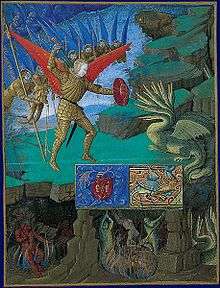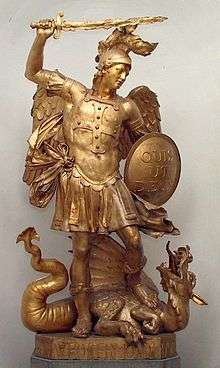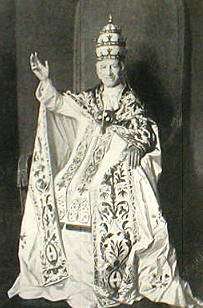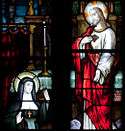Prayer to Saint Michael

The Prayer to Saint Michael usually refers to one Catholic prayer to Michael the Archangel, among the various prayers in existence that are addressed to him. This prayer was incorporated into the rubrics of the Low Mass of the Catholic Church from 1886 to its suppression in 1964.
Other prayers to Saint Michael have also been officially approved.
In the Leonine Prayers
In 1886, Pope Leo XIII added a Prayer to Saint Michael[1] to the Leonine Prayers, which he had directed to be prayed after Low Mass two years earlier.[2]
Sancte Michael Archangele,
defende nos in proelio;
contra nequitiam et insidias diaboli esto praesidium.
Imperet illi Deus, supplices deprecamur:
tuque, Princeps militiae Caelestis,
satanam aliosque spiritus malignos,
qui ad perditionem animarum pervagantur in mundo,
divina virtute in infernum detrude.
Amen.[1]Saint Michael Archangel,
defend us in battle,
be our protection against the wickedness and snares of the devil;
may God rebuke him, we humbly pray;
and do thou, O Prince of the heavenly host,
by the power of God, cast into hell
Satan and all the evil spirits
who prowl through the world seeking the ruin of souls.
Amen.[1]
- ^ Cite error: The named reference
EWTNwas invoked but never defined (see the help page).
Variant English translations have "Holy Michael", "Saint Michael", "malice and snares", "may God rebuke him", "cast into Hell", "all evil spirits", "prowl through the world seeking the ruin", and other differences.[3][4][5] The English translation that was used in Ireland is quoted in James Joyce's novel Ulysses.[6]
The prayer's opening words are similar to the Alleluia verse for Saint Michael’s feasts on 8 May and 29 September in the Roman Missal of the time, which ran:
Sancte Michael, defende nos in proelio ut non pereamus in tremendo iudicio.
Saint Michael, defend us in battle that we might not perish at the dreadful judgment.
History
The 'Leonine Prayers' originated in 1884, when Pope Leo XIII ordered certain prayers to be said after Low Mass, in defense of the independence of the Holy See. God's help was sought for a satisfactory solution to the loss of the Pope's temporal sovereignty, which deprived him of the evident independence required for effective use of his spiritual authority.[2] The prayer to St Michael described above was added to the Leonine Prayers in 1886.
The Pope's status as a temporal leader was resolved in 1929 by the creation of the State of Vatican City, and in the following year, Pope Pius XI ordered that the intention for which these prayers should from then on be offered was "to permit tranquility and freedom to profess the faith to be restored to the afflicted people of Russia".[7]
The practice of reciting this and the other Leonine prayers after Mass was officially suppressed by the 26 September 1964 Instruction Inter Oecumenici which came into effect on 7 March 1965.[8]
Removing the obligation to recite this powerful prayer (along with the three Hail Mary's, the Hail Holy Queen and the prayer for the Church) after Low Mass did not mean forbidding its use either privately or publicly in other circumstances; indeed, in his Regina Caeli Address on Sunday 24 April 1994, Pope John Paul II recommended its use, saying:
"May prayer strengthen us for the spiritual battle that the Letter to the Ephesians speaks of: 'Be strong in the Lord and in the strength of his might' (Ephesians 6:10). The Book of Revelation refers to this same battle, recalling before our eyes the image of St Michael the Archangel (cf. Revelation 12:7). Pope Leo XIII certainly had this picture in mind when, at the end of the last century, he brought in, throughout the Church, a special prayer to St Michael: 'Saint Michael the Archangel, defend us in battle. Be our protection against the wickedness and snares of the devil...' Although this prayer is no longer recited at the end of Mass, I ask everyone not to forget it and to recite it to obtain help in the battle against the forces of darkness and against the spirit of this world."[9]
Exorcism prayer

1890 original version
On 18 May 1890, twenty years after the capture of Rome had deprived the Pope of the last vestige of his temporal sovereignty, and the papal residence at the Quirinal Palace had been converted into that of the King of Italy, Pope Leo XIII granted indulgences to bishops and to priests lawfully authorized by their ordinaries who each day would devoutly recite a formula of exorcism against Satan and the rebel angels.[10]
The formula of exorcism, which was then inserted into the Roman Ritual,[11] contained within it a quite different prayer to Saint Michael, of which the following is an English translation:
In Nomine Patris, et Filii et Spiritus Sancti.
Princeps gloriosissime caelestis militiae, sancte Michael Archangele, defende nos in proelio et colluctatione, quae nobis adversus principes et potestates, adversus mundi rectores tenebrarum harum, contra spiritualia nequitiae, in caelestibus.
Veni in auxilium hominum, quos Deus creavit inexterminabiles, et ad imaginem similitudinis suae fecit, et a tyrannide diaboli emit pretio magno. Proeliare hodie cum beatorum Angelorum exercitu proelia Domini, sicut pugnasti contra ducem superbiae Luciferum, et angelos eius apostaticos: et non valuerunt, neque locus inventus est eorum amplius in coelo. Sed proiectus est draco ille magnus, serpens antiquus, qui vocatur diabolus et satanas, qui seducit universum orbem; et proiectus est in terram, et angeli eius cum illo missi sunt.
En antiquus inimicus et homicida vehementer erectus est. Transfiguratus in angelum lucis, cum tota malignorum spirituum caterva late circuit et invadit terram, ut in ea deleat nomen Dei et Christi eius, animasque ad aeternae gloriae coronam destinatas furetur, mactet ac perdat in sempiternum interitum.
Virus nequitiae suae, tamquam flumen immundissimum, draco maleficus transfundit in homines depravatos mente et corruptos corde; spiritum mendacii, impietatis et blasphemiae; halitumque mortiferum luxuriae, vitiorum omnium et iniquitatum.
Ecclesiam, Agni immaculati sponsam, faverrimi hostes repleverunt amaritudinibus, inebriarunt absinthio; ad omnia desiderabilia eius impias miserunt manus. Ubi sedes beatissimi Petri et Cathedra veritatis ad lucem gentium constituta est, ibi thronum posuerunt abominationis et impietatis suae; ut percusso Pastore, et gregem disperdere valeant.
Adesto itaque, Dux invictissime, populo Dei contra irrumpentes spirituales nequitias, et fac victoriam.
Te custodem et patronum sancta veneratur Ecclesia; te gloriatur defensore adversus terrestrium et infernorum nefarias potestates; tibi tradidit Dominus animas redemptorum in superna felicitate locandas. Deprecare Deum pacis, ut conterat satanam sub pedibus nostris, ne ultra valeat captivos tenere homines, et Ecclesiae nocere.
Offer nostras preces in conspectu Altissimi, ut cito anticipent nos misericordiae Domini, et apprehendas draconem, serpentem antiquum, qui est diabolus et satanas, ac ligatum mittas in abyssum, ut non seducat amplius gentes.In name of the Father, and of the Son, and of the Holy Ghost.
O glorious Archangel St. Michael, Prince of the heavenly host, defend us in battle, and in the struggle which is ours against the principalities and Powers, against the rulers of this world of darkness, against spirits of evil in high places (Eph 6:12). Come to the aid of men, whom God created immortal, made in his own image and likeness, and redeemed at a great price from the tyranny of the devil (Wis 2:23-24, 1 Cor 6:20).
Fight this day the battle of the Lord, together with the holy angels, as already thou hast fought the leader of the proud angels, Lucifer, and his apostate host, who were powerless to resist thee, nor was there a place for them any longer in Heaven. But that cruel, that ancient serpent, who is called the devil or Satan, who seduces the whole world, was cast into the abyss with all his angels (Rev 12:7-9).
Behold, this primeval enemy and slayer of man has taken courage, Transformed into an angel of light, he wanders about with all the multitude of wicked spirits, invading the earth in order to blot out the name of God and of his Christ, to seize upon, slay and cast into eternal perdition souls destined for the crown of eternal glory.
This wicked dragon pours out, as a most impure flood, the venom of his malice on men of depraved mind and corrupt heart, the spirit of lying, of impiety, of blasphemy, and the pestilent breath of impurity, and of every vice and iniquity.
These most crafty enemies have filled and inebriated with gall and bitterness the Church, the spouse of the Immaculate Lamb, and have laid impious hands on her most sacred possessions (Lam 3:15).
In the Holy Place itself, where has been set up the See of the most holy Peter and the Chair of Truth for the light of the world, they have raised the throne of their abominable impiety, with the iniquitous design that when the Pastor has been struck, the sheep may be scattered.
Arise then, O invincible prince, bring help against the attacks of the lost spirits to the people of God, and bring them the victory.
The Church venerates thee as protector and patron; in thee holy Church glories as her defense against the malicious powers of this world and of hell; to thee has God entrusted the souls of men to be established in heavenly beatitude.
Oh, pray to the God of peace that He may put Satan under our feet, so far conquered that he may no longer be able to hold men in captivity and harm the Church. Offer our prayers in the sight of the Most High, so that they may quickly conciliate the mercies of the Lord; and beating down the dragon, the ancient serpent, who is the devil and Satan, do thou again make him captive in the abyss, that he may no longer seduce the nations. Amen.[1]
This formula was not meant as a rite for exorcising a particular person but "for general use – to combat the power of the evil spirits over a community or locality".[12]
The prayer to Saint Michael that was included in this general exorcism had in fact been published and indulgenced two years earlier, in 1888, two years after the insertion of the more familiar Prayer to Saint Michael into the Leonine Prayers.[13]
1902 abbreviated version

In 1902, a year and a half before the death of Pope Leo XIII, a new edition of the Roman Ritual considerably shortened the formula as a whole and in particular the prayer to Saint Michael within it, making that prayer a sort of preface to the prayer of exorcism.[14] The prayer was shorn of the preceding version's paragraphs 2-6 and of the phrase "in thee holy Church glories as her defense against the malicious powers of this world and of hell" in paragraph 7.[13][15]
In his English version of the Roman Ritual, Philip T. Weller gives the following translation:[12]
In nomine Patris, et Filii et Spiritus Sancti.
Sancte Michaël Archangele,
defende nos in proelio;
contra nequitiam et insidias diaboli esto praesidium.
Imperet illi Deus,
supplices deprecamur: tuque,
Princeps militiae caelestis,
Satanam aliosque spiritus malignos,
qui ad perditionem animarum pervagantur in mundo,
divina virtute in infernum detrude.
Amen.In name of the Father, and of the Son, and of the Holy Ghost.
St. Michael the Archangel, illustrious leader of the heavenly army,
defend us in the battle against principalities and powers, against the rulers of the world of darkness and the spirit of wickedness in high places.
Come to the rescue of mankind, whom God has made in His own image and likeness, and purchased from Satan's tyranny at so great a price. Holy Church venerates you as her patron and guardian. The Lord has entrusted to you the task of leading the souls of the redeemed to heavenly blessedness. Entreat the Lord of peace to cast Satan down under our feet, so as to keep him from further holding man captive and doing harm to the Church. Carry our prayers up to God's throne, that the mercy of the Lord may quickly come and lay hold of the beast, the serpent of old, Satan and his demons, casting him in chains into the abyss, so that he can no longer seduce the nations.
Anthony Cekada and Brian Kelly suggest that improved relations between the Holy See and the Kingdom of Italy, which from 1900 was under a new king, lay behind the 1902 excision of phrases such as "These most crafty enemies have filled and inebriated with gall and bitterness the Church, the spouse of the Immaculate Lamb, and have laid impious hands on her most sacred possessions", and "In the Holy Place itself, where has been set up the See of the most holy Peter and the Chair of Truth for the light of the world, they have raised the throne of the abominable impiety, with the iniquitous design that, when the Pastor has been struck, the sheep may be scattered." These phrases have been interpreted as referring to the confiscation of Church property by the government of Victor Emmanuel II of Italy and to the occupation by the King of Italy of the Quirinal Palace, which had been the Pope's residence and seat of civil government.[13][16]
In 1999, the Vatican issued a revised version of its Rite of Exorcism. The Latin text of the 1902 prayer to St Michael was retained, unedited, in Appendix I. The Latin text of the 1886 prayer is also included, in Appendix II.[17]
Prayer of consecration

The Opus Sanctorum Angelorum presents the following prayer as an Act of Consecration to Saint Michael the Archangel:
Oh most noble Prince of the Angelic Hierarchies, valorous warrior of Almighty God and zealous lover of His glory, terror of the rebellious angels, and love and delight of all the just angels, my beloved Archangel Saint Michael, desiring to be numbered among your devoted servants, I, today offer and consecrate myself to you, and place myself, my family, and all I possess under your most powerful protection.
I entreat you not to look at how little, I, as your servant have to offer, being only a wretched sinner, but to gaze, rather, with favorable eye at the heartfelt affection with which this offering is made, and remember that if from this day onward I am under your patronage, you must during all my life assist me, and procure for me the pardon of my many grievous offenses, and sins, the grace to love with all my heart my God, my dear Savior Jesus, and my Sweet Mother Mary, and to obtain for me all the help necessary to arrive to my crown of glory.
Defend me always from my spiritual enemies, particularly in the last moments of my life.
Come then, oh Glorious Prince, and succor me in my last struggle, and with your powerful weapon cast far from me into the infernal abysses that prevaricator and proud angel that one day you prostrated in the celestial battle. Amen.[18][19]
Stories about the origin of the prayer

An article in the Roman journal Ephemerides Liturgicae (V. LXIX, pages 54–60) in 1955 gave an account in Latin and Italian of how the Saint Michael prayer (in the Leonine Prayers) originated. Footnote nine of this account quotes an article in another Italian journal called La Settimana del Clero in 1947 by Domenico Pechenino, who worked at the Vatican during the time of Leo XIII, in which he said that after Leo had celebrated a Mass, he seemed to be staring at something, then went to his private office, with his attendants asking if he was well. Half an hour later he had written the Saint Michael prayer.
According to the same article in Ephemerides Liturgicae,[20] Giovanni Nasalli Rocca Cardinal di Corneliano wrote in his Litteris Pastoralibus pro Quadragesima (Pastoral Letters for Lent) that according to Leo's private secretary, Rinaldo Angeli, Leo had seen a vision of demonic spirits who were congregating on the Eternal City (Rome); he wrote the Saint Michael prayer, and often said it, in response to the vision. Leo also personally wrote an exorcism prayer included in the Roman Ritual, and recommended that bishops and priests read these exorcisms often in their dioceses and parishes. He himself often recited them.[21]
Several variants of this story are told. The first to appear in print was in a 1933 German Sunday newspaper article, which stated that, as a result of the vision, shortly after 1880 Leo ordered the prayer to Saint Michael to be recited. In reality, it was only in 1884 that the Pope instituted the Leonine Prayers, still at that time without the prayer to Saint Michael.[22] A year later, a German writer, Fr. Bers, tried to trace the origin of the story and declared that, though the story was widespread, nowhere could he find a trace of proof. Sources close to the institution of the prayer in 1886, including an account of a conversation with Leo XIII about his decision, say nothing of the alleged vision. Bers concluded that the story was a later invention that was spreading like a virus.[23] The story is also found in Carl Vogl's 1935 Begone Satan: A Soul-Stirring Account of Diabolical Possession in Iowa.[24]
In a later version, the vision is said to have occurred not in 1880, but on 13 October 1884, the year in which the Leonine Prayers were instituted but without the Prayer to Saint Michael. And yet another date, 25 September 1888, two years after Pope Leo XIII had added the prayer to the Leonine Prayers, was given in a 1991 version.[25]
Another reported version of the vision relates a detailed conversation between the voice of Satan, who said he would destroy the Church if given enough power and time, and the voice of God, who permits Satan to do what he will.[26][27] According to William Saunders, writing in the Arlington Catholic Herald, Leo said that God permitted Satan to choose a single century in which to work his worst against the Church; he chose the 20th century, and God privately revealed the then-future events of the 20th century to Leo.[28]
See also
- Chaplet of Saint Michael
- Leonine Prayers
- Novena to Saint Michael
- Saint Michael in the Catholic Church
- Vade retro satana
References
- ↑ Irish Ecclesiastical Review 7 (1886), 1050
- 1 2 Decree Iam inde ab anno of the Sacred Congregation of Rites of 6 January 1884.Acta Sanctae Sedis 16 (1884), pages 249–250
- ↑ Alfred Boeddeker, "Our Guardian Angels"
- ↑ Prayer to St. Michael the Archangel
- ↑ Catholic Online, "Prayer for the Church # 3"
- ↑ Frederick K. Lang, Ulysses and the Irish God (Bucknell University Press 1993 ISBN 978-0-8387-5150-3), p. 112
- ↑ Allocution Indictam ante of 30 June 1930, in Acta Apostolicae Sedis 22 (1930), page 301
- ↑ Inter Oecumenici, 48 j
- ↑ John Paul II, Regina Caeli address 24 April 1994; cf. Prayer to St Michael; Mary Serves Cause of Life
- ↑ Exorcismus in satanam et angelos apostaticos iussu Leonis XIII P. M. editus. 18 May 1890.Acta Sanctae Sedis 23 (1890), pages 743–747
- ↑ Rituale Romanum, 6th ed. post typicam, (Ratisbon: Pustet 1898), 163*ff.
- 1 2 The Roman Ritual, translated by PHILIP T. WELLER, S.T.D., Part XIII, Chapter III.
- 1 2 3 Anthony Cekada, "The St. Michael Prayer: A 'Falsified' Text?"
- ↑ The revised Latin text of the exorcism is given in Title XI, chapter 3, pp. 285-286 of the online text of the Roman Ritual published by Laudate Dominum Liturgical Editions.
- ↑ Anthony Cekada, Russia and the Leonine Prayers, website accessed 22 May 2014, cites supplementary material bound into back of Pustet Rituale Romanum, 6th ed., (1898). “Concordat cum suo Originali, asservato penes Secretariam S. Congregationis Indulgentiis sacrisque Reliquiis praepositae. In fidem etc. Ex Secretaria Sacror. Rituum Congregationis, die 7. Januarii 1902. [l.s.] + D. Panici Archiep. Laodicen. S.R.C. Secretarius.”
- ↑ Brian Kelly, "The Leonine Prayers and the Conversion of Russia"
- ↑ De exorcismis et supplicationibus quibusdam. Libreria Editrice Vaticana. 2004. ISBN 978-88-209-4822-1., pages 76 and 83.
- ↑ Opus Sanctorum Angelorum, "Saint Michael the Archangel – Act of Consecration"
- ↑ Lisa Schmidt, "Consecrate Your Home to St. Michael the Archangel"
- ↑ p.58-59, footnote nine
- ↑ This account, which speaks not of the prayer included in the Leonine Prayers but of the general exorcism of which the prayer was at first |(1990) part, and for which it later (1902) served as a sort of preface, an exorcism that the Pope recommended bishops and exorcist priests to perform often, indeed daily, in their dioceses and parishes, and that he himself recited often throughout the day.
- ↑ "Nachdem Leo XIII. eines Morgens die heilige Messe zelebriert hatte, begab er sich zu einer Besprechung mit den Kardinälen. Aber plötzlich sank er in Ohnmacht zusammen. Die herbeigeeilten Arzte fanden keinen Grund zu dieser Ohnmacht, obwohl der Pulsschlag fast aufhörte. Plötzlich erwachte er wieder und war frisch wie zuvor. Er erzählte dann, er hätte ein furchtbares Bild gesehen. Er durfte die Verführungskünste und das Wüten der Teufel der kommenden Zeiten in allen Ländern sehen. In dieser Not erschien St. Michael, der Erzengel, und warf den Satan mit allen seinen Teufeln in den höllischen Abgrund zurück. Daraufhin ordnete Leo XIII. kurz nach 1880 das allgemeine Gebet zum heiligen Michael an." Hg. Schnell in the Konnersreuther Sonntagsblattes (1933), no. 39, quoted in Bers “Die Gebete nach der hl. Messe”, Theol-Prakt. Quartalschrift 87 (1934), 161.
- ↑ "Like a perpetual sickness" – "Die Gebete nach der hl. Messe", Theol-Prakt. Quartalschrift 87 (1934), 162-163
- ↑ Reprinted by TAN Books (Rockford IL) in 1973.
- ↑ Gary Giuffré, "Exile of the Pope-Elect, Part VII: Warnings from Heaven Suppressed", Sangre de Cristo Newsnotes 69–70 (1991), 4
- ↑ The Religious Congregation of Mary Immaculate Queen
- ↑ Tremblay, Joe (1 February 2013). "The 100 year test". Catholic News Agency. Retrieved 29 June 2016.
- ↑ Saunders, William (2 October 2003). "St. Michael the Archangel". Arlington Catholic Herald. Diocese of Arlington. Retrieved 29 June 2016.
External links
- Russia and the Leonine Prayers
- Pope John Paul II's Regina Coeli Address of 24 April 1994 (in Italian)
- The Vision Of Pope Leo XIII
Bibliography
- Georges Huber, Arrière Satan! le diable aujourd'hui (Paris: Tequi, (1992), pp. 18–20; Spanish translation.


